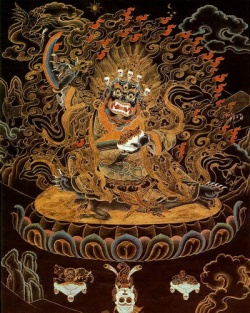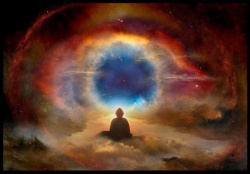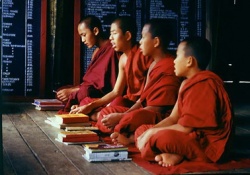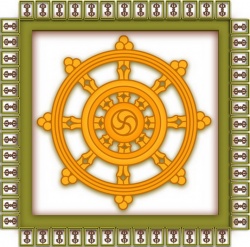The Symbolism of the Five Buddhas Male and Female by Sangharakshita
... sexual differences. So one finds now at this stage, the Ideal Buddha divided into two figures, one male, one female, inseparably united. And these two figures thus united are sometimes symbolised by the Vajra, or Dorje, and the Lotus.
Or by the Vajra, or Dorje, and the Bell. But we've not yet reached the end of the development.
Not only does the Archetypal Buddha divide in this way, into two figures, male, female, sexually united, but all the other four Buddhas similarly divide. So now we've got not just five Buddhas, but ten Buddhas. We've got five so-called male Buddhas, and five so-called female Buddhas, and the female Buddhas are regarded as the consorts of the male Buddhas. As spiritually united with them. So now a few words about each of these so-called female Buddhas in turn. After that we'll just refer to the final development in this five-fold, or now ten-fold symbolic pattern, and then conclude.
The first of the female Buddhas is Akashadatesvari. She is the consort of Vairocana, the white Buddha, the Buddha of the centre. Akashadatesvari. And her name means, 'The Sovereign Lady of the Sphere of Infinite Space.' We recollect that Vairocana himself is the Sun, the 'Sun Buddha', he's the Sun of the Whole Cosmos, the whole spiritual cosmos. He's radiating light, radiating heat in all directions. The light of Wisdom, the heat of Love. And Akashadatesvari, the Lady, the Sovereign Lady of the Sphere of Infinite Space, she represents, she embodies the infinite space through which the rays of the light of Vairocana fall. She represents unlimited spiritual receptivity. Or she represents the whole of the phenomenal world, the whole of the phenomenal universe, as pervaded, completely pervaded, absolutely pervaded, by the influence, by the influence if you like of the Absolute. In the language of 'The Awakening of Faith' she represents the whole of phenomenal existence as thoroughly perfumed by the Absolute. And like Vairocana, Akashadatesvari is white in colour. And she's represented in Dakini form. That is to say she's represented with loose flowing garments, and long dishevelled hair.
Secondly, Locana. Locana is the consort of Aksobhya, the deep blue Buddha, the Buddha of the East. And her name means 'The Clear Visioned One'. Or literally, 'The One with an Eye.' In Tibetan her name is translated as 'Lady of the Bigger Eye,' or 'Lady Possessing the Bigger Eye.' And Locana, 'The One with the Eye', is the embodiment of clear awareness. She represents, or she embodies, pure simple direct awareness of things. And Aksobhya whose consort she is, Aksobhya is especially connected with Transcendental Wisdom. He's practically the only Buddha who appears in the Sutra of Transcendental Wisdom, especially the one in eight-thousand lines; and what does this association suggest? It suggests, - there's no wisdom without Awareness. No Awareness without Wisdom. The two are inseparably connected. In a sense are different aspects of the same spiritual experience. And Locana is light blue in colour.
And then thirdly, Mamaki. Mamaki is the consort of Ratnasambhava, the yellow Buddha, the Buddha of the South. And her name means, 'Mine Maker.' She's the one who makes everything 'Mine', not in of course, a selfish egoistic sense, as one is now on the level of Enlightenment; makes everything her own. Mamaki is that spiritual attitude that regards everything, everyone, as mine, my own. In the sense of my VERY own. Near and dear to me. Precious to me. Valuable to me. So Mamaki actually experiences everybody as it were, enjoys everybody. Delights in everybody. Rejoices in everybody. Even, one might say, regards everybody as her own self. Sees no difference between herself and others. They're all mine. Or even 'me'. And her colour is yellow.
Fourthly, Pandaravasini. Pandaravasini is the consort of Amitabha, the red Buddha, the Buddha of the West. And her name means 'The White Robed One.' It suggest one who is as it were, vested in purity. Even, insulated by purity. And the imagery here recalls that, which is connected with, the fourth Dhyana, the fourth state of meditation. Or higher consciousness. You may remember that the Buddha symbolised this by saying that one's experience in this Dhyana, this state of higher consciousness, was like that of a man who on a hot day, for he was tired and dusty, had taken a bath. And after taking a bath. And after taking a bath, of course not under a tap, or in a bathroom, but in a beautiful pond, full of lotuses, after taking this bath, had come out and wrapped himself in a pure white sheet. So this wrapping in a pure white sheet, in the white robe, represents as it were the concentration and gradual accumulation of one's energies, especially emotional energies, one's insulation of them from possibly harmful outside influences. So Pandaravasini is the White Robed One. The one isolated, insulated, from outside influences. And she's light red in colour.
And fifthly and lastly we come to Tara. Tara is the consort of Amoghasiddhi. The deep green Buddha, the Buddha of the North. And her name means, 'The One who Ferries Across.' Ferries across the river, ferries across the river of birth and death, river of Samsara. And she recalls, in her function, the Buddha's 'parable of the raft'. When the Buddha said the teaching, the Dharma, is like a raft. It's to help you to get across. Across the river of Birth and Death. The name Tara is often translated as 'Saviouress', but this can be rather misleading, we may say that Tara represents the attitude of helping people to help themselves. So these are the five so-called female Buddhas. Akashadatesvari - The Sovereign Lady of the Sphere of Infinite Space, Locana - the One with the Eye, Mamaki, the Min-Maker, Pandaravasini, the White Robed One, and Tara, the Helper, the One Who Ferries Across. And these five female Buddhas, together with their male counterparts, represent different aspects of the one integral Enlightenment experience. An experience which is essentially, in its depths, in its essence, an experience of the inseparable two-in-one-ness of Wisdom and Love.
We come now to the final development in the symbolic pattern with which we're concerned tonight. A development which has been anticipated to a limited extent in one at least of the previous lectures. We described the five male Buddhas, described the five female Buddhas, but they've been described, all of them, in just one particular way. Under one particular aspect. We've described them all, male and female Buddhas alike, under their peaceful aspect. But this is just one aspect. As I mentioned last week, in the esoteric Tantras, the Buddhas and Bodhisattvas appear under a double aspect. Under two aspects. There's a peaceful aspect, and there's a wrathful aspect. So this applies to the five Buddhas too. To the five male Buddhas, and the five female Buddhas. So I'm going to say a few words about them in their wrathful form and then conclude.
These wrathful forms are much less highly individualised than the peaceful forms.
And in their wrathful forms, the five Buddhas are known as, 'The Five Herukas.' That is to say that the five male Buddhas are known as 'The Five Herukas.' And they're all named after their respective Buddha families. There's the Buddha Heruka, the Vajra Heruka, the Ratna Heruka, the Padma Heruka, and the Karma Heruka. And each one is represented as strongly, powerfully, even massively built, represented as naked, except for a tiger skin or an elephant hide, and they all wear garlands of human skulls. And round their bodies and round their arms are twined snakes.
They usually possess at least six arms, sometimes very many more. And each has three eyes.
Three bulging enflamed eyes. And each has a wrathful expression. And they're usually represented as trampling on their foes. The enemies of the Dharma. And as moving violently to the right. And they're surrounded each one, by a halo of flames. The Buddha Heruka is dark blue in colour, or black. The others are blue, yellow, red and green respectively. Now the consort of the Buddha Heruka, the equivalent female Buddha is known simply as Crodeshvari, which may be translated as 'Our Lady of Wrath.' And the consorts of the other Herukas are also named after their respective Buddha families. So one has the Vajra Lady of Wrath, the Jewel Lady of Wrath, the Lotus Lady of Wrath, the Action Lady of Wrath, all depicted in the same kind of way. They're all depicted naked, or practically naked, of the same colour as their consort, but lighter, and as somewhat smaller in size. And in each case they cling on to the front of their consort. Sometimes with their arms clasped round his neck.
Such then we may say, is the symbolism of the Five Buddhas, the male and the female, the peaceful and the wrathful. Such, one of the most important, one of the most beautiful and meaningful patterns in the whole range of the Tantra; a pattern that organises part at least, of the riches of the Tantra into a form that we can appreciate and perhaps assimilate. And in the midst of all these forms, while envisaging, even visualising these forms, we must never forget that all of them, whether male or female, peaceful or wrathful, all of these symbols represent different aspects of the Enlightenment experience. Different aspects of Buddhahood. Must never forget that they all embody spiritual experiences, are the product indeed of spiritual experiences. If we remember this, that these symbols embody spiritual experiences, then perhaps we shall be able to respond to them, if we respond to them we shall be helped by them. We shall be helped in fact, we may say, by all the creative symbols of the Tantric Path to Enlightenment.



